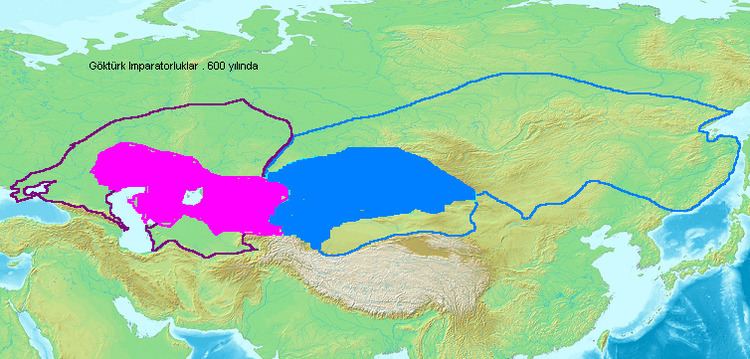 | ||
The Göktürk civil war (or Turkic interregnum) was an important crisis in Central Asia during the 580s, which resulted in the split of the Göktürk Khaganate and the creation of separate western and eastern khaganates.
Contents
Background
The Turkic Khaganate or Göktürks, was a vast empire stretching between the Chinese Empire and the Black Sea. The name of the ruling dynasty was Ashina. The khagans were appointed by the kurultay (council of tribe leaders).
Beginning of the interregnum
In 581, the fourth khagan Taspar Qaghan died. There were four claimants to throne. The personal and regnal names are shown below:
Prince Anlo was Taspar Qaghan's son, Talopien (Apa Qaghan) and Shetu (Ishbara Qaghan) were Taspar's nephews, while Tien-chueh (Tardu) was Taspar's cousin. (see Göktürk family tree)
Before dying, Taspar Qaghan had announced his preference for Talopien to succeed him instead of his son Anlo, although he had no right to determine the succession. During the kurultay after Taspar Qaghan's death, Shetu, who was also a claimant, saw that he had no chance and supported the pacifist Anlo on the ground that Talopien's mother was not of noble birth. He threatened the kurultay that in case of Talopien's election he would revolt. Thus the kurultay appointed Anlo as the new khan. However Anlo's regency was short-lived because of the reaction of Talopien's partisans. Anlo quickly renounced the title on behalf of his powerful ally Shetu who became the khan with the regnal name Ishbara Qaghan.
Partition
Ishbara Qaghan was the central khagan, residing in the holy forest Ötüken in central Mongolia. But the other claimants were not subdued. The second khagan was Tardu, now called Tardush Qaghan, who chose the Tien Shan mountains in western China as his seat, and became the de facto ruler of all western territories. The third khagan was Anlo, who controlled the region around the Tuul River in Mongolia. Talopien, now called Apa Qaghan, was sovereign in the northern territories.
Civil war
In 584, Ishbara Qaghan raided Apa Qaghan's territory and killed the Apa Qaghan's mother. Apa Qaghan took refuge in the west and allied himself with its powerful ruler Tardu. Both Tardu and his brother Tamgan (Turksanf), the ruler of the Volga river area, supplied him with troops. Ishbara Qaghan wasn't able to compete with this force, and accepted the suzerainty of Sui China to protect himself. With Chinese support he was able to capture Apa Khagan's family members. Apa Qaghan once again escaped west and settled in the Paykend near Bukhara (in modern Uzbekistan). However, in his new territory, the former alliance broke and he lost the support of Tardu because of the disagreement over the control of the Silk Road. In 587, both Ishbara Qaghan and Apa Qaghan died.
Aftermath
After the death of Ishbara Qaghan and Apa Qaghan the new khagan was Bagha Qaghan, Ishbara Qaghan's brother. He tried to unite the khaganate, but couldn't control the western portion, where the ambitious Tardu was acting independently. After 593, the khaganate was partitioned into two, and the two parts remained separate except for a brief period in the early eighth century. The Turks of the western part settled in parts of European Russia and Turkestan.
